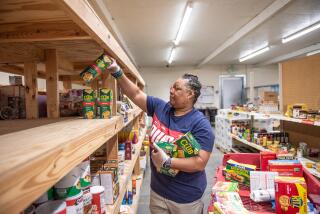Getting Help From Local Programs
- Share via
Those who find that they can’t qualify for government cash aid, or find that the cash aid isn’t enough, may be able to get help paying for groceries, handling medical expenses, finding child care and getting housing through one of several state- and county-operated programs.
Although administered locally, many of these programs are mandated by the federal government, which means that the rules are relatively standard throughout the states. Those who meet the criteria are usually guaranteed aid.
However, the reporting requirements are often voluminous. In some states, the initial application to get food stamps runs 14 pages and the subsequent monthly reports required are equally lengthy. In addition, many states expect recipients to sign up for work or employment training programs to continue receiving aid. But if the applicant must participate in a jobs program, the state agency provides child care or reimbursement for baby-sitting costs, when needed.
The main nationally available programs are as follows:
* Food stamps are provided to individuals and families with limited income and assets. The stamps, which normally come in booklets of $1 coupons, can be used to buy groceries, but not alcohol or clothing. To qualify, the applicant may not have income exceeding 130% of the federal poverty guidelines and cannot have liquid assets--including cash, stocks, bonds and savings accounts--worth more than $2,000.
The value of a personal residence and personal possessions, as well as the cash value of life insurance policies and certain pension plans, are exempt from the calculation.
Allowable monthly income levels are standard throughout the contiguous United States, but slightly higher for Hawaii and Alaska. A family of four can take home more than $1,000 a month and still qualify for food stamps. It’s important to note that the net income figure permits a number of exclusions, including an allowance for taxes, out-of-pocket dependent care expenses, and shelter expenses of up to $186 a month (in fiscal 1991).
Individuals who are already receiving cash help through the Aid to Families with Dependent Children program automatically qualify for food stamps.
In fiscal 1991, average monthly food stamp benefits were roughly $64 per person.
* Medicaid provides hospital, doctor, laboratory, X-ray and skilled nursing care services, as well as family planning and pharmaceuticals. Anyone already receiving AFDC payments is eligible, as are a number of those excluded from the AFDC program. Some states, for instance, limit AFDC payments to two-parent households. These families can get AFDC aid just six months out of 13. Nevertheless, they are eligible for Medicaid coverage throughout the year.
In addition, some individuals who have recently found work and no longer qualify for AFDC benefits are still able to maintain Medicaid coverage for a one-year period. However, in the second half of the year, they may be required to make co-payments when using Medicaid services.
* Child care assistance is provided to AFDC families who need child care help in order to work or participate in mandated jobs and training programs. The amount provided is the lesser of actual cost or $175 per month per child over the age of 2 and $200 per month per child under the age of 2. The agency that provides child care monies also has the option of providing the baby-sitting services themselves.
Those who no longer qualify for AFDC because of recently secured employment can get transitional child care. And those who earn too much for AFDC, but are at risk of falling into the aid program because of an inability to find and finance child care, may also apply for child care assistance.
* There are a number of programs that subsidize both permanent and temporary housing for low-income families. An individual’s ability to qualify depends on a variety of factors, including income, assets, current living arrangements and availability of housing. In some cases, state and county agencies will provide cash covering up to four weeks of temporary shelter.
Those who need more permanent arrangements may get grants of several hundred dollars to be used for security deposit and first and last month’s rent. Additionally, most large cities have a limited amount of low-income housing available. Usually, applicants sign up with their local housing authority, but the waiting lists can be long: Some people wait for years.
Finally, if you’re unable to qualify for any of these sources of aid, do not despair. There are local and private organizations also willing to help. Many of these programs are administered by churches, unions and national charitable organizations. Finding help can be as simple as picking up the phone book. In many cities, for instance, the United Way sponsors “Info Line”--a referral service that directs callers to the government agency or private organization best equipped to help them.
More to Read
Sign up for The Wild
We’ll help you find the best places to hike, bike and run, as well as the perfect silent spots for meditation and yoga.
You may occasionally receive promotional content from the Los Angeles Times.






